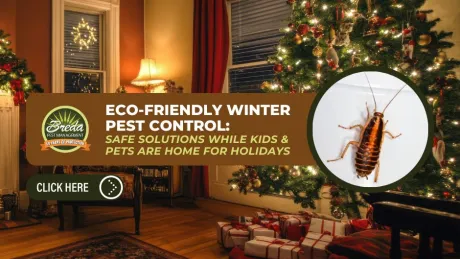You may not know you have a cockroach problem, or may not think of them as a problem, until they get into your home. But the first step to preventing them from getting into your home is to prevent them from getting into your yard. Unless they tag on to your clothes, or come into your home on an item you bring inside, they will always come in through your yard. So this post is here to help make your yard less desirable to cockroaches.
Before a Roach Problem
If you haven't seen many signs of a roach problem in your home or in your yard, but want to take a few steps to reassure that you don't develop a problem, the first step is to make some adjustments in your yard.
Trimming trees, plants and other vegetation in your yard that are too close, or encroaching on your home, is an easy and effective step. Having these plants growing so close to your home gives bugs a reason to discover your home and gives them easy access to it through natural habitation.
Cockroaches love to hide out in cluttered places, like in piles of decomposing leaves or wood. Try to maintain your yard so there aren't many places for these bugs to reside and breed.
Cockroaches are always looking for food. They will eat whatever they can find, but are drawn to, and follow, the scents they pick up. Make sure the lids to your garbage cans are secured properly to keep smells in, and bugs out.
If you have a compost pile or bin, keep it as far away from the house as possible. Keeping your compost at a very high temperature (around 160 degrees Fahrenheit) will deter bugs because it is too hot for them to nest and reproduce. Consider putting your compost in a container with a secure lid on top of it to keep bugs from getting inside.
Potential Roach Problem
If you have some signs of a problem, and think you may have an infestation, or be on the way to an infestation, but you aren't sure where they are coming from, place some sticky traps or gel baits around your property. Wherever the sticky traps catch the most roaches indicates the area with the most roach activity, which could be the main source of the problem.
Now that the sticky traps have told you which areas to focus on, apply boric acid or diatomaceous earth to them. These products are made to target and kill bugs. Boric acid can be toxic in high quantities if consumed by pets or children and can damage plants. That being said, diatomaceous earth might be a better option if you have to use a high quantity of product or are worried about your pets and children getting sick. Some common areas to apply these bug killing powders to are under porches, around sewer covers, and near drains. It is important to note that you should reapply after it rains, as the rain will likely wash away most of the powder.
During a Roach Problem
If you know you have a problem it's time to take some serious action. Spray a pesticide around the perimeter of your yard, or area of concern. Be careful with pesticides, because almost all pesticides on the market are toxic. Consider using a Cyfluthrin solution called CY-Kick CS. It only has a 6% concentration of Cyfluthrin, mixed with water that will deliver an insecticide deadly to roaches, but not to humans or pets. You will need a pump sprayer to spray it yourself, or ask a pest control operator to do it for you. Spray around the exterior of your home out to 1.5 feet from your building.
If your infestation is still a problem, call a trusted pest management specialist. For more information on cockroaches and how to keep your home free of them, check out our latest guide, How to Protect Your Home from Cockroaches.



